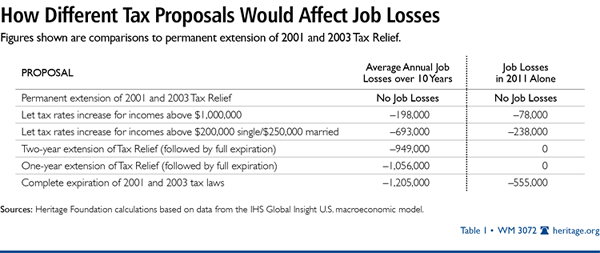There is near-universal agreement among economists that raising marginal tax rates during slow economic times only makes the economy weaker. Higher tax rates reduce employment, cut investment activity, and soften household demand for goods and services. Even so, Congress is considering right now a number of tax proposals, most of which raise tax rates starting on January 1, 2011. All but one of these legislative options would result in higher unemployment.
Some of these proposals raise tax rates on upper-income taxpayers. President Barack Obama has advanced a plan that increases tax rates on single incomes above $200,000 and married incomes above $250,000. Many Members of Congress back a one- or two-year temporary extension of the expiring 2001 and 2003 tax laws, thus delaying tax rate hikes until the economy has hopefully strengthened—but unfortunately also extending the uncertainty of the taxes, which dampens the incentive to make much-needed long-term investments. Unfortunately for Americans struggling to find jobs or higher incomes, each of these proposals makes their lives more difficult because of the harm they do to economic activity.
Happily, a growing number of Members support a permanent extension of the current, lower rates. Indeed, the only option for addressing the expiring 2001 and 2003 tax relief laws that does not damage the economy is their permanent extension. Continuing our current tax policy by making the 2001 and 2003 tax law changes permanent allows the economy to recover naturally, which means more job growth than would be the case under any of the other proposals being considered. In fact, once Congress reins in spending, a stronger economy will also produce additional revenues that will cause the deficit to shrink.
Members of Congress, however, will have to choose which economic path they want to take. The table below shows how many lost potential jobs would result from each of the options for addressing the expiring 2001 and 2003 tax laws currently being discussed. The way we estimated these economic impact results is described in the appendix at the end of this memo.
Appendix: Methodology
CDA analysts used a version of the IHS/Global Insight (GI) July 2010 short-term model of the U.S. economy to estimate the overall net economic effects of President Obama’s tax plan. The version used an adjusted baseline representing the most likely path of the U.S. economy if the government extends the current policies over the next 10 years.
The relationships in the model are calibrated by historical U.S. data and mainstream economic theory. The model is a tool that provides insight into likely magnitudes and the direction of economic variables due to policy changes. A dynamic analysis of a policy change is important because in an ever-changing and market-based economy, indirect and feedback effects need to be taken into account to get a true estimate of the likely overall economic impact.
Direct effects happen, for example, when many individuals make small changes in their labor and leisure tradeoff decisions. These changes, in turn, change capital-labor tradeoffs made by businesses. The macroeconomic model estimates these changes in relative prices dynamically such that these changes affect investment and output levels. Tax rate changes also affect disposable income and demand variables.
These variables have further feedback effects with supply variables as well as interaction with the fiscal revenues and spending variables. The feedback effects further increase or decrease the longer-term impact of the policy, providing a quantitative picture of whether the economy would tend to be stronger or weaker if the proposal were implemented compared to the baseline.
Description of the Adjusted Baseline. CDA analysts used a version of the GI July 2010 short-term model of the U.S. economy to estimate the overall net economic effects of President Obama’s tax plan.
This version of the GI July 2010 short-term model of the U.S. economy was employed so that its baseline fiscal and economic projections would reflect as close to current policy as possible—primarily assuming extensions of the 2001 and 2003 tax cuts for all income earners.[1]
In adjusting the GI July 2010 short-term model, CDA analysts made the following assumptions:
- The effective personal income tax rate was lowered in the adjusted baseline by removing assumed tax increases on high-income earners starting in 2011 and gradually increasing effective federal tax rates on all income earners beginning in 2012.[2]
- The maximum marginal tax rate on personal capital gains was lowered by removing the assumed increase on this tax rate of 5 percent—an assumed increase from the current maximum rate of 15 percent to 20 percent, including the 3.8 percent increase in the Medicare investment tax, which takes effect at the start of 2013.
- The average federal marginal tax rate was lowered by removing the increase due to the higher marginal tax rates assumed in the GI July 2010 short-term model.[3]
- A flat revenue amount was subtracted from an adjustment variable (GFRCPTUNIADJ—reconciliation item between the National Income and Product Accounts [NIPA] and unified federal outlays, billions of dollars, quarterly rate, Global Insight) in the GI July 2010 short-term model, since this model assumes an increase of approximately $32 billion to $33 billion per year from 2011 to 2020 due to the renewal of the estate tax. While there is a seasonal pattern in the revenue adjustment—primarily reflecting the difference in timing between cash receipts in the unified budget accounts and tax accruals in the NIPA—there is no assumed seasonal variation on the estate tax receipts.
Expiration Simulations. IHS/Global Insight’s July 2010 short-term forecast made assumptions regarding the expiration of the 2001/2003 tax rates. In July, the forecast assumed that by 2013, the rates would be fully expired for everyone.[4] Thus the average effective and average marginal rates assumed by GI were used to adjust the current policy baseline for the three expiration scenarios: starting in 2011 for the full expiration, starting in 2012 for the one-year extension, and starting in 2013 for the two-year extension.
The variable for the maximum capital gains rate was also changed to 20 percent starting in 2011, 2012, and 2013, respectively, for the three expiration scenarios. Additionally, in 2013 to the end of the forecast, the rate was further increased by 3.8 percentage points to reflect the Obamacare tax on capital income that takes effect that year.
The details on the $200,000/$250,000 expiration simulation can be found in the methodology appendix in a previously published CDA report.[5]
William W. Beach is Director of, Karen A. Campbell, Ph.D., is Policy Analyst in Macroeconomics in, John L. Ligon is a Policy Analyst in, and Guinevere Nell is Research Programmer in the Center for Data Analysis at The Heritage Foundation.






